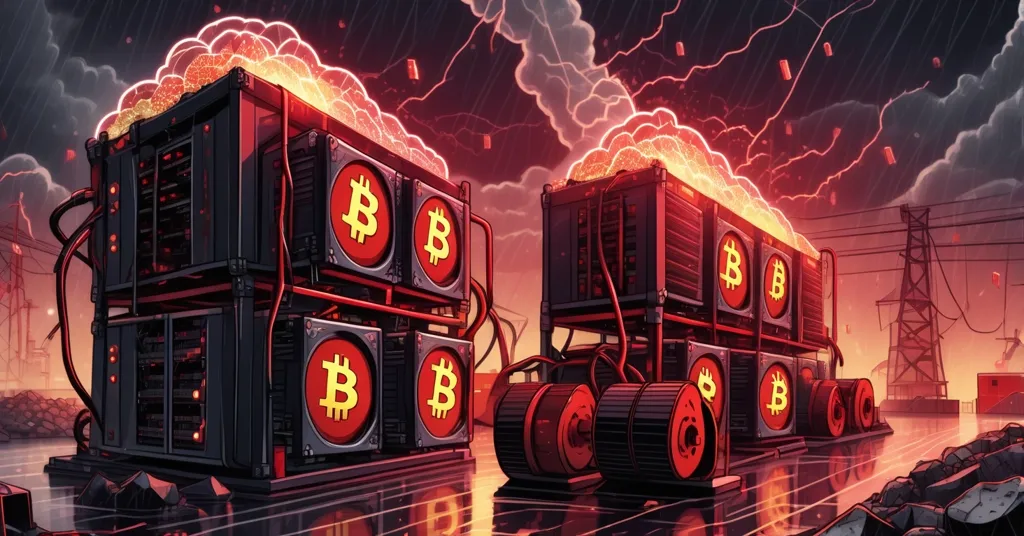US Bitcoin Miners Hit by Tariffs as IREN Overtakes MARA in 2025 Showdown

US Bitcoin Miners Slammed by Tariffs as IREN Steals MARA’s Crown
Bitcoin mining in the United States is caught in a brutal crossfire of skyrocketing operational challenges, punishing tariffs on critical hardware, and murky political entanglements, all while a new champion rises in the production race. As miners grapple with financial blows and competitive shifts, the future of this industry hangs in a delicate balance between disruption and disaster.
- Tariff Hell: Retroactive tariffs on ASIC rigs hit CleanSpark and IREN with potential liabilities of $185M and $100M, while Trump’s 100% chip tariff looms as a death knell.
- Difficulty Spikes: Bitcoin mining difficulty soared to a record 129.44 trillion hashes, crushing margins despite BTC prices climbing past $115,000.
- IREN’s Triumph: Producing 728 BTC in July 2025, IREN dethroned MARA (703 BTC) with a record $83.6M revenue haul.
- Political Intrigue: American Bitcoin Corp (ABTC), linked to the Trump family, eyes a public listing with heavy backing from the Winklevoss brothers.
Tariff Hell: A Financial Wrecking Ball for US Bitcoin Miners
The US Bitcoin mining sector is getting hammered by a policy sledgehammer in the form of tariffs on ASIC rigs, the specialized hardware that powers Bitcoin mining. These machines, mostly produced by Chinese giants like Bitmain, MicroBT, and Canaan Inc., are purpose-built for one job: solving the complex mathematical puzzles that secure the Bitcoin blockchain and earn miners their rewards. There’s no substitute for ASICs—they’re indispensable, which makes the latest tariff barrage all the more devastating. Retroactive tariffs on imports between April 2024 and February 2025 have left major players reeling, with CleanSpark (NASDAQ: CLSK) facing a potential $185 million liability and IREN (NASDAQ: IREN) on the hook for up to $100 million. These aren’t just balance sheet blips; they’re financial wrecking balls that could shatter profitability for firms already skating on thin ice.
As if that wasn’t enough to bleed miners dry, President Donald Trump dropped a bombshell with a proposed 100% tariff on imported chips and semiconductors. If enacted, this could turn importing ASICs into a ‘go to hell’ tax, making costs skyrocket to unsustainable levels. For an industry reliant on cutting-edge hardware to stay competitive, this is akin to cutting off oxygen. US Customs and Border Protection is already enforcing retroactive penalties, and companies are scrambling to prove their rigs aren’t of Chinese origin—a bureaucratic nightmare that’s costing time and money they don’t have. The impact of these proposed tariffs on companies like CleanSpark and IREN could redefine the landscape in 2025. The stakes couldn’t be higher: either miners absorb these costs, pass them on through higher fees, or watch their operations grind to a halt.
Globally, the ripple effects are already visible. Ethan Vera, COO of Luxor Technology, nailed the likely outcome with a stark prediction:
“ASIC manufacturers [will ship] more rigs to overseas markets with more favorable import tariffs.”
Bitmain is scoping out US operations in Texas or Florida to dodge future tariffs, while MicroBT shifts production to places like Malaysia. This isn’t uncharted territory—during Trump’s first term, similar tariffs pushed Chinese manufacturers to Southeast Asia. But for US miners caught in the crosshairs now, the damage may already be done. These policies, while pitched as a boost for domestic manufacturing, risk pushing hashrate—the computational power securing Bitcoin—overseas to mining-friendly regions like Canada or Kazakhstan. So much for Trump’s vision of the US as a global Bitcoin mining hub, a concern echoed in discussions on platforms like Reddit about tariff challenges.
Difficulty Spikes: The Silent Killer of Miner Margins
Tariffs aren’t the only force turning the screws on US miners. The Bitcoin network itself is making life hell with record-high mining difficulty, hitting an all-time peak of 129.44 trillion hashes on August 9, 2025. For the uninitiated, mining difficulty is like a puzzle that gets tougher the more people try to solve it. It’s a built-in mechanism to ensure new Bitcoin blocks are mined roughly every 10 minutes, keeping the network stable. But when difficulty spikes—marking the 11th increase this year and a 17.73% jump since January—it means miners need more computational power, and thus more energy and money, to earn the same rewards. Think of it as the total brainpower miners are throwing at Bitcoin’s puzzles, with peak hashrates reaching a staggering 976 exahashes per second (EH/s). That’s a lot of juice, and a lot of cash, as detailed in this analysis of mining difficulty’s impact on profitability.
This comes on the heels of the April 2024 halving, a core Bitcoin feature that slashes miner rewards by 50% every four years to enforce scarcity and drive long-term value. It’s like a throttle on digital money printing—great for BTC’s price, brutal for miners who see their income halved overnight. While a price rally has offered some relief, with Bitcoin surging from $94,500 on January 1, 2025, to over $115,000 by July (peaking near $123,000), it’s a shaky lifeline. JPMorgan analysts pointed out a silver lining:
“Miners’ July profits were better than any month since the April 2024 halving of the block rewards.”
But don’t get too cozy. That price bump, possibly fueled by institutional adoption and ETF inflows, isn’t guaranteed to last. Meanwhile, difficulty spikes keep pushing operational costs through the roof, especially in energy-intensive regions like Texas where heatwaves have disrupted uptime. Smaller miners are getting crushed, unable to afford the latest rigs or the power bills, raising a red flag for Bitcoin’s decentralized ethos. If only a handful of corporate giants can keep up, is Bitcoin still the rebel’s currency we champion?
Energy Costs and Environmental Heat: A Double Whammy
Speaking of power, energy costs tied to these difficulty hikes are a silent killer. Mining Bitcoin isn’t just about hardware; it’s about feeding those rigs with cheap, reliable electricity. As difficulty climbs, so does the energy needed per coin mined, and with US electricity prices varying widely by state, many miners are stuck paying premium rates. Add to that summer heatwaves—particularly brutal in mining hotspots like Texas—and you’ve got cooling systems working overtime or operations shutting down entirely. It’s not uncommon for miners to lose days of productivity just because the grid can’t handle the load or the weather turns hostile, a challenge explored in this report on energy costs for Bitcoin mining.
Some are adapting by chasing low-cost energy zones or pivoting to renewables like solar and hydro to dodge both tariffs and environmental backlash. But scaling green tech isn’t cheap or fast—it’s another hurdle in an already stacked deck. Environmental scrutiny is only growing, with critics pointing to Bitcoin’s carbon footprint as a reason to regulate or outright ban mining. For an industry built on freedom from centralized control, the irony of facing government heat over energy use isn’t lost on anyone. The question lingers: can miners innovate fast enough to stay profitable without sacrificing Bitcoin’s core principles?
IREN’s Rise: Efficiency or the Road to Monopoly?
Amid this chaos, a new king has emerged in the US mining scene. IREN pulled off a jaw-dropping upset in July 2025, mining 728 BTC to overtake longtime leader MARA, which clocked in at 703 BTC. With a beefy hashrate of 45.4 EH/s and record monthly revenue of $83.6 million, IREN’s ascent isn’t just a symbolic win—it’s proof that efficiency and scale are now non-negotiable in this cutthroat game, as highlighted in this comparison of IREN and MARA performance. MARA’s CEO Fred Thiel didn’t shy away from the harsh truth:
“Any advantage in any market starts disappearing when you have lots of companies going after it … they can’t all be successful.”
MARA isn’t rolling over, though. They’re eyeing a stake in Exaion, a subsidiary of Électricité de France, to build out AI infrastructure—a clear signal that pure Bitcoin mining might not be enough to survive. Riot Platforms’ CEO Jason Les echoed the need for diversification:
“Progressively shifting capacity toward high-value data centers [promises] more consistent returns.”
IREN’s rise begs a deeper question: are we witnessing the triumph of innovation, or the first steps toward a monopoly? As smaller players get squeezed out by difficulty and tariffs, hashrate is concentrating among titans like IREN, MARA, and Riot. This centralization trend—evident with pools like Foundry USA and AntPool dominating global hashrate—could make Bitcoin vulnerable to 51% attacks or regulatory capture. For a network built on the promise of no single point of control, that’s a bitter pill to swallow.
Earnings Roundup: Who’s Winning and Losing in Q2 2025?
Financial snapshots from Q2 2025 reveal just how volatile this sector is. MARA posted a hefty $238.5 million in revenue, up 64% year-over-year, with a staggering profit of $808.2 million. Riot Platforms doubled their haul to $153 million, banking a $219 million profit. CleanSpark raked in $198.6 million (up 91%) and a profit of $257.4 million, though the sudden resignation of CEO Zach Bradford raised eyebrows. Their official statement was diplomatic but telling:
“The board believes that now is the right time for a change in leadership as we look to fully capture opportunities available to CleanSpark.”
Not everyone’s riding the BTC price wave to Easy Street. Cipher Mining reported $44 million in revenue but a net loss of $46 million, while TeraWulf’s $47.6 million in revenue came with an $18.4 million loss. Hut 8, meanwhile, logged $41.3 million in revenue and a $137.5 million profit, boosted by Bitcoin’s value gains on their balance sheet. These mixed results lay bare a harsh reality: miner success hinges on BTC price swings and operational agility. One wrong move—or one bad quarter—and you’re bleeding red. Tariffs and difficulty only amplify the gamble, a topic of debate on platforms like Quora regarding tariff effects on miners.
Political Games: Trump, ABTC, and Bitcoin’s Rebel Soul
Now let’s wade into the murkier waters of politics. American Bitcoin Corp (ABTC), born from a partnership with Hut 8, is gearing up for a public listing through a merger with Gryphon Digital Mining. What makes this a lightning rod is its ties to the Trump family. Eric Trump, as Chief Strategy Officer, holds a 9.3% stake potentially worth $475 million. Crypto heavyweights Cameron and Tyler Winklevoss, founders of Gemini, have backed ABTC with Bitcoin in its $220 million private placement, alongside a $4 million donation to a Trump-affiliated PAC. With Donald Trump publicly pushing to make the US a Bitcoin mining powerhouse, the optics are impossible to ignore, as detailed in this update on ABTC and Trump family involvement.
Here’s the rub: while some cheer a pro-Bitcoin White House, others smell a trap. Could political backing turn BTC into just another Wall Street plaything, co-opted by the very systems it was built to reject? Trump’s broader crypto ventures—like World Liberty Financial, a DeFi project tied to the family—only deepen the skepticism. Bitcoin’s anti-establishment crowd might just gag at the thought of their currency becoming a partisan pawn. Sure, favorable policies could ease tariff pain or boost domestic mining, but at what cost to the ethos of decentralization and freedom we hold dear? It’s a tightrope walk between opportunity and betrayal.
What This Means for Bitcoin’s Future
Peering through the chaos, US Bitcoin mining stands at a crossroads. On one hand, the price rally to over $115,000 and efficiency gains by firms like IREN signal resilience and potential for growth. Miners adapting to renewable energy or diversifying into AI and data centers show the kind of grit that fuels innovation. Yet the risks are glaring: tariffs threaten to choke supply chains, difficulty spikes and energy costs push small players out, and political ties risk tainting Bitcoin’s soul. Historically, US-China trade wars (like those in 2018-2020) jacked up hardware costs, and we’re seeing déjà vu now—only this time, the stakes feel higher with centralization looming, as noted in reports like this overview of US miners and tariff probes.
Let’s play devil’s advocate on Trump’s involvement. A US mining hub sounds like a win, but if it comes with strings attached to political agendas, it could alienate Bitcoin’s core community. Worse, if hashrate keeps concentrating—whether due to costs or policy favoritism—Bitcoin’s security and decentralized promise could erode. A 51% attack, where one entity controls over half the network’s power, isn’t just theory; it’s a real risk if giants keep consolidating. Then there’s the environmental angle: as miners migrate to cheap energy, will regulators crack down harder, especially if public backlash grows? Bitcoin was born to disrupt, but can it survive being dragged into the very systems it spits in the face of? That’s the million-BTC question.
Key Questions and Takeaways on US Bitcoin Mining Challenges in 2025
- How are tariffs crippling US Bitcoin miners?
Retroactive tariffs on ASIC hardware slam giants like CleanSpark with $185M and IREN with $100M in potential liabilities, while Trump’s 100% chip tariff could choke supply chains, spiking costs across the board. - What’s driving Bitcoin mining difficulty to record highs?
Hitting 129.44 trillion hashes, difficulty forces miners to burn more energy and cash for fewer coins, crushing smaller players despite BTC’s climb past $115,000 offering some relief. - Why did IREN surpass MARA as top Bitcoin producer?
Mining 728 BTC in July 2025 with $83.6M revenue, IREN’s efficiency and 45.4 EH/s hashrate outpaced MARA’s 703 BTC, proving scale is survival in a ruthless market. - What’s the significance of Trump and ABTC in Bitcoin’s image?
ABTC’s Trump family ties and Winklevoss backing could win policy favors for US mining, but risk painting Bitcoin as a political tool, clashing with its decentralized, rebel spirit. - How do Q2 2025 earnings expose mining’s volatility?
MARA and Riot scored massive profits ($808.2M and $219M), while Cipher and TeraWulf bled losses, showing a sector teetering on BTC price swings and operational grit. - Are tariffs and difficulty threatening Bitcoin’s decentralization?
Soaring costs and small miner collapse concentrate hashrate with corporate titans, risking Bitcoin’s core promise of a network no single entity can control—a danger we can’t ignore.



